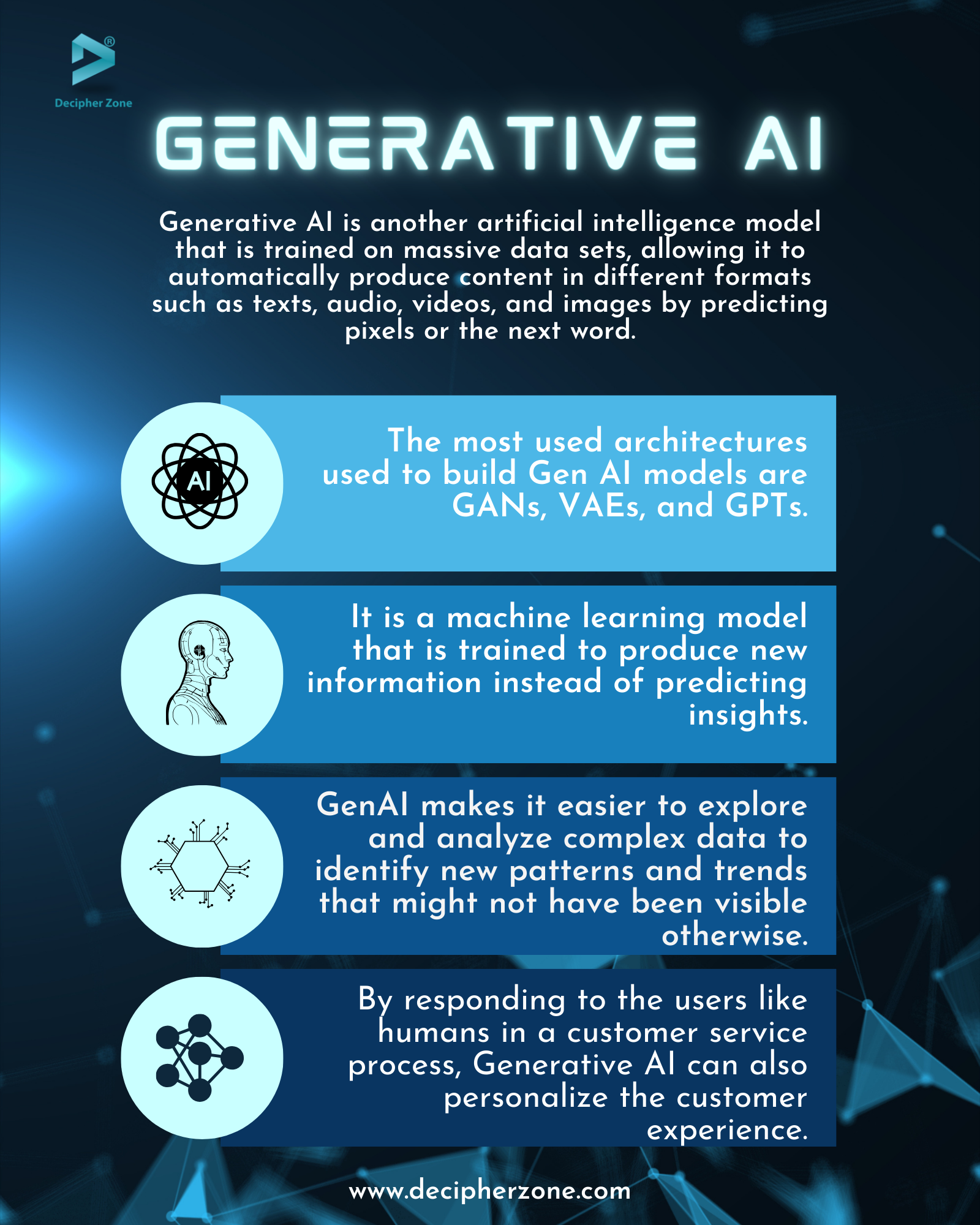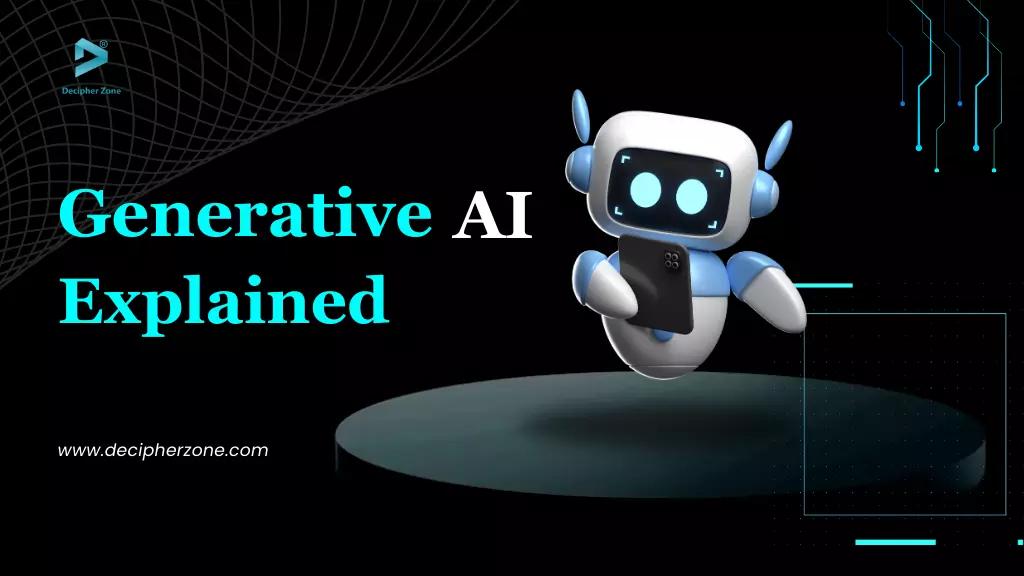2023 was the year where we witnessed a rapid rise in the adoption of AI, specifically generative AI. A quick go-through of the headlines makes it clear that generative AI is everywhere. A few popular ones you might have heard of or used are ChatGPT, Dall-E, GitHub’s Copilot, Google’s Gemini, Bing AI, Jasper, and Synthesia. Even the market size of generative AI is expected to reach $1.3 trillion over the next decade.
But wait, what is Generative AI? How does it work? What are its use cases?
In this blog, we will cover every perspective of Generative AI to help answer all the questions running through your head. So, without waiting any longer, let’s get into it.
Read: How AI is Changing The Future of eCommerce
Understanding Artificial Intelligence
The first step towards learning about generative AI is understanding what artificial intelligence is and what it uses to accomplish given tasks.
Artificial Intelligence is the branch of computer science that creates smart machines to perform tasks that usually require human intelligence. Some popular examples of AI that we use in our daily lives are voice assistants, autonomous vehicles, GPS guidance, and, how can we forget, Generative AI.
Some of the tasks that can be performed using AI are speech recognition, pattern detection, and gaming. AI systems process massive amounts of data and look for patterns to learn and identify patterns to make decisions. While some AIs require supervision from humans to learn and reinforce good decision-making, others are designed to learn without supervision.
AI systems work by leveraging different AI models and techniques such as Machine Learning, Deep Learning, Natural Language Processing, Neural Networks, and Computer Vision. Let’s understand each of these in better detail as it will help Generative AI more effectively.
Read: How Is Artificial Intelligence Revolutionizing Marketing?
Machine learning refers to AI’s subfield that uses data and algorithms to empower AI to mimic the way humans learn, slowly improving its accuracy. At its core, ML focuses on creating, implementing, and improving algorithms to facilitate predictions and decision-making, improving AI performance over time.
Deep learning is the subset of machine learning algorithms that runs data and inputs through neural networks inspired by the human brain. It teaches AI to process data as humans, it can recognize differences between patterns of text, sound, images, and more for producing highly accurate predictions and insights.
Natural Language Processing (NLP) gives machines the ability to interpret spoken and written language as humans. It combines machine learning, linguistics, computer science, and deep learning methods to support the analysis of unstructured voice data and text to extract required information through it.
Neural networks are a series of algorithms that are composed of a group of attached nodes that impersonate the structure of the human brain and pass information among each other. It allows AI systems to learn from mistakes and errors.
Read: Prospects of Artificial Intelligence in Software Testing
Last but not least, computer vision is another subset of artificial intelligence that allows computers to process data like videos, images, visual media, etc. to process and provide insights into them.
This brings us to the main topic of the blog - Generative AI.
What is Generative AI?
Generative AI is another artificial intelligence model that is trained on massive data sets, allowing it to automatically produce content in different formats such as texts, audio, videos, and images by predicting pixels or the next word.
As ChatGPT is one of the renowned platforms based on Generative AI, it will be easier to understand from its example. Similarly to the ChatGPT prompt, when a user puts a simple text input with what they want, the algorithms of Generative AI start generating new content to give the required output.
That being said, generative AI can be considered a machine learning model that is trained to produce new information instead of predicting insights based on given datasets. It can use both supervised and unsupervised learning methods for training, giving the ability to easily use a massive amount of unstructured data to build foundational models or bases for AI systems that can perform numerous tasks.
Read: Benefits of Using AI for Product Design
Earlier Gen AI versions were all about developers submitting data through API or other more complicated processes. Now, experts in gen AI have designed and built better UIs to interact with it in simple language instead of working with big data analytics, programming codes, writing algorithms, logic, and all that used to go with working with AI.
Types of Generative AI
Generative AI can be used for different tasks but for each task you want it to perform it requires different deep learning algorithms that help it identify patterns and features from the data provided for training. Below, we have enlisted the most commonly leveraged architectures used to build Gen AI models.
Generative Adversarial Networks (GANs)
It is a machine learning framework class that is used in generative AI. GANs have two neural networks that they train by competing against each other to produce new, highly authentic data from a given dataset.
While one network generates new data by taking samples from given input data and modifying it, another predicts if the newly generated data belongs to the original dataset.
Some of the applications of GANs include generating images, generating data training for other models, generating 3D models, and completing missing information.
Generative Pre-trained Transformers (GPTs)
GPTs belong to the neural network model family. It uses transformer architecture which is a deep learning architecture that learns context by tracking sequential data relationships.
The transformer follows an encoder-decoder architecture to generate an output without relying on recurrence (used to analyze sequential data) and convolutions (used to solve spatial data problems) networks. It gives users the ability to generate text and content like humans.
Read: AI-Powered Future
Variational Autoencoders (VAEs)
Variational autoencoders are neural networks that compress and reconstruct data. VAEs describe the observation of a latent space through a probabilistic approach.
They are made up of two elements: an encoder and a decoder. The encoder receives input and compresses it into a latent space representation, while the decoder takes this representation and creates new data that captures essential characteristics of the training data.

Benefits of Generative AI
From what we have learned so far, you might have a better vision of the benefits that can come from Generative AI adoption for a business. However, for your better understanding, we have enlisted some of the most potential advantages of generative AI. These are as follows:
-
It can be used to create new, original, and human-like text and content for creative arts, ads, and entertainment.
-
Generative AI makes it easier to explore and analyze complex data to identify new patterns and trends that might not have been visible otherwise.
-
It also helps in automating the process of summarizing complex data into readable narratives.
-
GenAI can also improve the accuracy and proficiency of existing AI systems.
-
By responding to the users like humans in a customer service process, Generative AI can also personalize the customer experience.
Read: Benefits of Using AI for Product Design
Conclusion
So that was all about Generative AI. We hope that you enjoyed learning about different aspects of GenAI along with what it is, how it benefits a business, and everything in between.
Needless to say, GenAI is not going anywhere and is here to stay. And if as a business you are planning to take advantage of this technology then consider hiring an AI system development companywith years of experience and expertise.
All you have to do to hire developers is get in touch with our experts for a free consultation and quote today!

